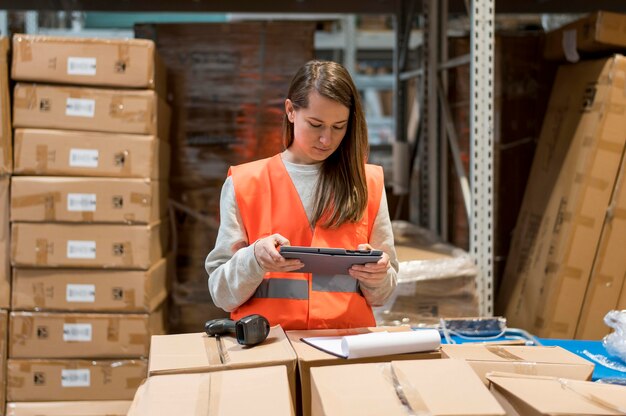A successful order-fulfillment process increases your profits and lets you earn your customer’s loyalty. On the other hand, inefficient order fulfillment systems can ruin your business. That is why you must know what order fulfillment is about and how your customer receives your products.
If you run a startup, you might handle your own order fulfillment. However, larger companies can rely on third parties since order fulfillment can be complex over country borders.
In this blog, we will walk you through what does fulfillment status mean and how to build a good order fulfillment system. You will also receive the dos and don’ts in order fulfillment.
What Does Fulfillment On An Order Mean?
Order fulfillment is part of the supply chain, right before shipping. In other words, it involves processing the order, which is currently being prepared for shipment.
Order fulfillment is critical in any business because it directly impacts customer satisfaction. Elaborating on it, a proper order fulfillment chain increases your sales and income. On the other hand, a poor order fulfillment process slows deliveries, increases costs from damaged or lost products, and dissatisfies customers.
Difference Between Order Status and Fulfillment Status?
Both order and fulfillment status refer to the stage of a customer’s order. The difference is that order status is more overarching. With order status, you look at whether an order has been received, processed, archived, or canceled.
And what does fulfillment status mean? This indicates the current stage of an order during the processing. To better understand fulfillment status, consider someone ordering a set of notebooks from you.
- Unfulfilled: If you have yet to even start to put the order together, then it is unfulfilled.
- Scheduled: When you organize for an order to be fulfilled at a later time, you are scheduling it. This helps both you and the customer know the order will be processed.
- Partially Fulfilled: If you have put two of the three notebooks in the package and are still looking for the third one in the warehouse, it is partially fulfilled.
- On Hold: If you realize you have run out of the third notebook, you can put the order on hold until it is available. This helps distinguish between orders that are actively being processed and those that require something else before they can proceed.
- Fulfilled: If you put together all the different notebooks and got them ready for transport, that order would be fulfilled.
Types of Order Fulfilment
An order is a customer request for a good. And there are many ways for this order to be fulfilled. Here are some order fulfillment options:
1. In-House Order Fulfillment
With in-house order fulfillment, you handle receiving the order from the customer, putting together the requested goods, and taking them to shipping. There is one great benefit of in-house order fulfillment. This method lets you resolve issues quickly. For example, if you realize a package is missing an item, you can add it yourself instead of contacting a warehouse only after the customer has noted the missing item. After all, you don’t need to coordinate with a warehousing company. However, larger companies will be required to invest heavily in infrastructure and labor to implement this type of order fulfillment.
2. Dropshipping Order Fulfillment
Dropshipping involves paying the manufacturing company to fulfill orders. For example, you might be selling a makeup palette. And so, you might pay the manufacturer to simply add your logo, take the orders, and send out the palettes.
Dropshipping reduces inventory costs and unsold goods. The downside of dropshipping is the loss of control over quality. In addition, if the dropshipping company makes mistakes, such as sending damaged items, or sending a product from a different company, it will negatively affect your brand.
3. Third-party logistics
Third-party logistics companies optimize your order fulfillment process as they take over parts of it. Third-party logistics companies offer a mix of the following services:
- Warehousing
- Order fulfillment
- Inventory management
- Transport
- Customer care
- Returns and replacements
The main advantage is that by expertly handling parts of your supply chain, you can focus on your main business. However, you need a close partnership if you want to quickly fix issues such as returns and delays. An example of such a company is Amazon. They offer warehousing, order fulfillment, transport from the warehouse to the customer, and can even handle returns and replacements.
4. Hybrid Order Fulfillment
The hybrid fulfillment allows companies to mix the different types of order fulfillment benefits. For instance, you can get the benefit of third-party logistics: A low investment cost by letting another company handle your warehousing needs. Or you can get the benefit of in-house fulfillment: Being able to control quality by handling the final packaging.
The point of hybrid fulfillment is to give you the maximum options so you can find a system suited to your business. For example, since you’re using several order fulfillment methods, you get flexibility in how much you invest in your supply chain. However, handling any part of this system requires expert labour.
The Challenges of Order Fulfillment
- Inventory Management: Without dedicated experts in charge of tracking item stock, predicting demand, and producing products, maintaining correct inventory levels becomes difficult.
- Trends: Changes in consumer trends and demand fluctuation impact inventory. And so an order may become difficult to fulfill since inventory has been adjusted to the new trend.
- Policies: Trade sanctions, taxes, and other government policies affect order fulfillment. This is because the order needs to pass through a separate process or might not even be legal to process.
- Errors: When your product contains a defect or harms the users, fixing this mistake is resource-intensive and costly.
Strategies to Overcome Order Fulfillment Problems
Start small
While your system is small, you can become familiar with the order fulfillment process and learn how to optimize your fulfillment, how to handle returns, etc.
Arrange your storage
It does not matter if it’s your kitchen pantry or a large warehouse; it should be arranged. Service delivery speed increases when your storage remains optimum for picking and packaging products. Place hot-ticket items closer to the final processing area.
Organize Backup Shipping and Logistics
Yes, you may have your go-to companies, but you need a backup plan. This means finding alternatives to your third-partners. For instance, you can look into a second warehouse and get a quote in case you ever need it. This not only safeguards against emergencies but also gives you leverage should you want to switch third parties.
Automate Fulfillment Process
Make use of automation during the fulfillment process. Machines work for long durations and reduce labor costs because they can keep packing while workers require breaks. Moreover, workers can only work so many hours in a day before needing someone else to take over their shift. The drawback of automation in fulfillment is that you need to investigate maintenance costs before buying.
Tips for a Successful Order Fulfilment
- Budget: Work within your budget. If your company is small, opt for in-house order fulfillment.
- Find Experts: When you have limited access and experience in fulfillment and logistic skills, you can opt to outsource.
- Set expectations: Set clear service-delivery expectations with customers so customers have realistic ideas of the process and are not disappointed.
- Manage Inventory: Optimize your storage and inventory to minimize shortages, which slow down order fulfillment.
- Build Relationships: Have a dedicated staff that deals with all your third parties. Through them, maintain strong relationships with your third-party vendors, transporters, and suppliers.
Conclusion
Understanding “what does fulfillment status mean” is crucial for those just starting their e-commerce business. Order fulfillment can make or break your business. When you fail at this stage, your customers can become angry, and your brand might even take a hit. This might be why some companies choose to pay a third party. Still, this brings issues. For example, with dropshipping, you can’t easily control quality. Nevertheless, you can opt for a hybrid system whereby you handle parts of the order fulfillment while a company with experts in the field also works with you. In any case, for successful order fulfillment, you should consider building strong relationships with every company you work with.
FAQs
What does it mean when the status is fulfilled?
When the status is fulfilled, it means that your order has been put together and just needs to be shipped out.
What is shipping in order fulfillment?
Shipping is the transportation of goods from one location to another.









